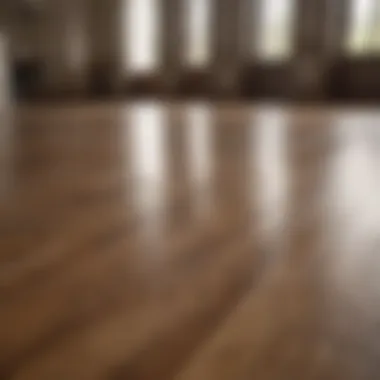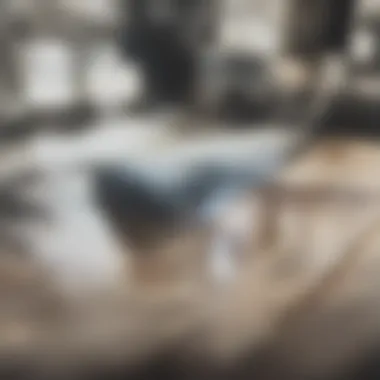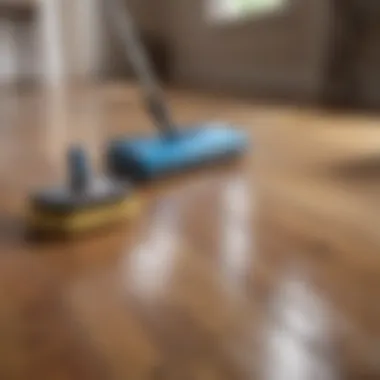Efficient Techniques for Disinfecting Hardwood Floors


Intro
Hardwood floors are more than just a surface to walk on; they represent a significant investment in a home’s aesthetic and value. However, maintaining their beauty requires diligent care, particularly when it comes to disinfection. Traditional cleaning methods can often risk damaging the wood, making understanding the optimal approaches for disinfecting crucial.
In this article, we explore methods that effectively sanitize hardwood floors without compromising their integrity. By focusing on tailored solutions, tools, and techniques, we aim to provide a comprehensive guide that empowers homeowners and cleaning enthusiasts. The discussion covers cleaning solutions, tools specific to hardwood care, and preventive measures to ensure longevity.
By adhering to the recommendations outlined here, you will not only enhance the hygiene of your living space but also prolong the aesthetic appeal of your hardwood flooring.
Prolusion to Disinfecting Hardwood Floors
Disinfecting hardwood floors is a topic of significant relevance, particularly for homeowners who seek to maintain both cleanliness and aesthetic appeal in their living spaces. The process of regular disinfection ensures that floors do not merely maintain their look but are also free from harmful microbes and allergens. This approach not only protects the health of individuals but also extends the lifespan of the flooring material. In this discussion, we will delve into effective methods and considerations that are essential when disinfecting hardwood floors.
Importance of Disinfection
Disinfection is particularly important in environments with high foot traffic. From children playing to pets roaming around, hardwood floors are susceptible to dirt, dust, and various contaminants. By implementing a robust cleaning routine, homeowners can significantly reduce the risk of slips, falls, and illnesses caused by germs. Moreover, disinfecting does not just focus on appearance; it also addresses the accumulation of bacteria and viruses.
The process of regular disinfection promotes a healthier indoor environment, especially for sensitive individuals. Allergens such as dust mites and pet dander can exacerbate symptoms for those with allergies or respiratory issues, making effective cleaning a necessity. Using suitable disinfectants can help mitigate these risks.
Common Contaminants on Hardwood Floors
Various contaminants can find their way onto hardwood floors. Understanding these is crucial for effective cleaning. Here are some common ones:
- Dirt and Dust: These are everyday issues, particularly in homes located in windy areas or where there is outdoor access. Accumulated dirt can scratch the floor surface.
- Food Particles: Kitchens tend to be hotspots for spills and crumbs. Food particles can attract pests and create unpleasant odors.
- Pet Hair and Dander: For pet owners, hair and dander are constant issues that require regular attention. Without proper cleaning, these can become embedded in the flooring.
- Spills: Whether it is a drink or cleaning products, spills can lead to damage if not cleaned promptly.
- Microorganisms: Germs, bacteria, and viruses can linger on surfaces, especially when multiple people interact within the same space.
"A thorough understanding of common contaminants allows for targeted cleaning methods, ensuring your hardwood floors remain beautiful and safe."
In summary, a systematic approach to continual disinfection is vital for maintaining the integrity of hardwood floors. An informed strategy ensures that not only is the floor kept pristine but also that the overall health of the home environment is preserved.
Essential Considerations Before Cleaning
Before embarking on the journey of disinfecting hardwood floors, it is crucial to consider several foundational elements. Understanding these aspects not only aids in selecting the appropriate cleaning methods but also ensures that the floor's integrity and appearance are preserved. Each hardwood finish has distinct characteristics requiring tailored approaches. Furthermore, adhering to manufacturer guidelines can prevent damage, maintain warranties, and promote long-lasting beauty. Lastly, evaluating the room's use and foot traffic provides insight into cleaning frequency and the type of disinfectants suitable for the environment.
Type of Hardwood Finish
The finish applied to hardwood floors plays a pivotal role in determining the cleaning technique. Various finishes, including polyurethane, oil-based, and wax finishes, have unique properties that influence their susceptibility to moisture and substances. Polyurethane finishes, for instance, are more resistant to water and easier to clean with commercial disinfectants. On the other hand, wax finishes may require gentler cleaning solutions to avert stripping the wax away, which can lead to dullness and increased wear.
Before proceeding, identify the specific type of finish on your hardwood floors. Use a gentle cleaner for oil-based finishes, while water-based polyurethane finishes can tolerate more robust disinfectants. This informed choice will not only enhance cleanliness but also ensure the floor's longevity.
Manufacturer Guidelines
Consulting the manufacturer's guidelines is a crucial step that cannot be overlooked. Each hardwood floor brand often provides specific recommendations tailored to its products. These guidelines typically include recommended cleaning agents, dilution ratios, and cleaning frequency. Adhering to these instructions ensures compatibility with the finish and minimizes the risk of damage.
In various instances, following manufacturer guidelines can maintain the warranty intact. If any issues arise, manufacturers may require proof that proper care was administered. This adherence fosters greater trust in the entire cleaning process and promotes the floor's aesthetic appeal over time.
Room Use and Foot Traffic
Lastly, an assessment of the room's use and foot traffic is essential when considering cleaning approaches. High-traffic areas, such as entryways or living rooms, accumulate dirt and bacteria rapidly. This necessitates a more stringent cleaning regime, possibly involving frequent disinfection sessions. Conversely, rooms used less frequently may only need periodic cleaning, allowing for a less aggressive approach.
For rooms with pets or children, consider additional precautions while selecting cleaning agents. Many harsh chemicals could pose health risks, making the use of eco-friendly or natural solutions a wise choice.
Important Note: Taking these considerations into account ensures the cleaning approach is tailored, maintaining both the functionality and aesthetics of your hardwood floors.
Effective Cleaning Solutions


In maintaining hardwood floors, selecting the right cleaning solutions is vital. Cleaners affect not only the cleanliness of the surface but also the durability and appearance of the finish. Understanding the various options available allows homeowners to make informed decisions, facilitating safe and effective disinfection. The goal is to keep the hardwood looking pristine while ensuring that harmful bacteria and contaminants are eliminated.
Commercial Disinfectants
Commercial disinfectants are widely available and often specifically formulated for different floor types. They typically offer a quick and effective solution for disinfecting hardwood floors. When choosing a commercial product, it is crucial to select one that is compatible with your floor's finish. Brands like Bona and Murphy provide specialized cleaners designed to sanitize while being gentle on wood.
These products often boast properties like:
- Fast-Acting Formula: Known for their immediate effectiveness against germs.
- Ease of Use: Typically come ready to use, requiring no additional mixing.
- Variety of Options: Available in sprays, concentrates, or wipes to suit various cleaning styles.
While commercial disinfectants are convenient, it's important to read guidelines on their use carefully. Misuse can lead to residue accumulation or discoloration of the finish.
Natural Disinfection Options
For those who prefer eco-friendly solutions, natural disinfection options are a viable alternative. Ingredients like vinegar and essential oils display excellent antimicrobial properties. Firstly, vinegar is effective in neutralizing odors and cutting through grease. Although it should be diluted before application to prevent damage, it stands as a popular choice for many conscientious homeowners.
Some natural options to consider include:
- Tea Tree Oil: Known for its antifungal and antibacterial properties. A few drops mixed with water can create a potent cleaning solution.
- Lemon Juice: Its acidity helps to remove stains and provides a fresh scent.
- Baking Soda: Particularly useful for specific stains. Make a paste with water and apply as needed.
While natural cleaners pose lower risks to the environment, they might require more frequent applications to achieve the same level of disinfection as commercial products.
Homemade Cleaning Solutions
Creating homemade cleaning solutions is another approach that allows for customization according to individual needs. A simple mix of common household ingredients can yield an effective disinfectant for hardwood floors. Formula suggestions include:
- Vinegar Solution: Combine equal parts of water and white vinegar in a spray bottle. Use during regular cleaning to freshen and disinfect.
- Liquid Soap Mix: Mix a tablespoon of mild liquid soap in a gallon of warm water. This solution is safe for floors and provides additional cleaning power.
Remember to always test any new solution on a small, inconspicuous area of the floor before applying it broadly. This prevents potential damage or discoloration.
Utilizing these safe, homemade alternatives not only encourages a more sustainable cleaning routine but also assures a residue-free finish that enhances the wood's natural beauty.
In summary, effective cleaning solutions are essential for maintaining the integrity and hygiene of hardwood floors. By evaluating options—commercial, natural, and homemade—homeowners can adopt strategies that best fit their lifestyle and ensure a healthier living environment.
Step-by-Step Cleaning Process
The step-by-step cleaning process for hardwood floors is crucial. It ensures that each stage of disinfection is done correctly, minimizing the risk of damage to the surface while achieving effective results. A systematic approach not only enhances the overall hygiene of your home but also prolongs the life of your flooring. Homeowners must understand the significance of each step. This enables them to avoid common pitfalls and execute an efficient cleaning routine.
Preparation of the Area
Preparation is key when cleaning hardwood floors. Before any cleaning solution is applied, it is essential to remove all furniture and items from the floor. This includes chairs, tables, and decorative pieces. Doing so allows access to every corner, making the cleaning thorough. Sweeping or vacuuming the floor helps eliminate dust and debris. If not removed, these particles can scratch the wood surface during the cleaning process.
Using a soft-bristered broom or a vacuum cleaner with a hardwood-specific attachment will ensure the floor is free from loose dirt. After this, inspect for spills or stains that may need special attention. Treating these spots beforehand can make the overall cleaning more effective. After this step, check the light levels in the room. Ensuring adequate lighting will help identify any missed areas in the following steps.
Application of the Cleaning Solution
When it comes to applying the cleaning solution, following the manufacturer guidelines is paramount. Pre-mixed commercial disinfectants can be effective, but homeowners may also opt for natural solutions. Whatever the choice may be, the solution should be applied by using a mop or cloth specifically designed for hardwood floors.
It is advisable to dampen the mop rather than soaking it. Excesswater can seep into the seams of the hardwood, leading to warping or other damage. Start at one end of the room, moving in sections towards the exit to avoid walking on clean areas. Use a gentle circular motion, which helps lift grime without scratching. In areas where stains exist, focus cleaning efforts there while ensuring the rest of the floor receives equal attention.
Drying and Finishing Touches
Drying the floor after cleaning is more than just waiting for it to air dry. A proper drying process helps maintain the finish of the hardwood. It is critical to use a clean, dry microfiber cloth for enhancing dryness and removing any leftover residue. This cloth should be used in long, even strokes to remove any streaks left by the cleaning solution.
"Ensuring that floors are completely dry before returning furniture prevents marks and potential scratches."


Once dry, inspect the floor for any missed spots before placing furniture back. Consider applying a maintenance product designed for your specific type of hardwood, helping to enhance shine and protection. Following these steps yields a cleaner and more hygienic environment, ensuring your hardwood flooring remains a stunning feature in your home.
Tools and Equipment for Disinfection
Selecting the right tools and equipment for disinfecting hardwood floors is paramount to achieving not only a clean surface but also preserving the aesthetic qualities of the flooring. Using the appropriate tools allows for effective application of cleaning solutions, ensuring that disinfectants penetrate properly without damaging the finish of the wood. It is important to choose equipment that is designed specifically for hardwood floors to avoid scratches or other damage.
There are several key types of tools that homeowners should consider when preparing for disinfecting their hardwood floors. Each plays a distinct role in the process and contributes to an overall successful outcome.
Mops and Pads
Mops and pads designed for hardwood floors are essential. They allow for even distribution of cleaning solutions without excessive moisture, which can harm wooden surfaces. Microfiber mops are particularly beneficial. They can trap dust, dirt, and microbes effectively.
Additionally, they tend to require less water compared to traditional mops, making them less likely to saturate the wood. It's wise to choose mops that have removable pads, as these can be easily washed and reused. This not only enhances hygiene but also reduces waste.
Buckets and Sprayers
Utilizing the right containers and tools for applying disinfectants is crucial. Buckets are typically used for manual application, allowing for thorough soaking of the cleaning pads. Conversely, sprayers offer a more controlled application of liquid solutions. Opting for a sprayer that provides fine mist can be advantageous. It reduces the risk of over-saturation and ensures even coverage across floor surfaces, which is especially important for delicate finishes. When using either, avoid mixing different types of cleaning solutions in one container as this can lead to chemical reactions.
Microfiber Cloths
Microfiber cloths are another indispensable tool when disinfecting hardwood flooring. Their fine fibers enable them to capture small particles and bacteria effectively. Using microfiber cloths for spot cleaning after general disinfecting can help to effectively remove any residual stains or sticky spots that mopping may not fully address. Furthermore, they are also non-abrasive, which is crucial for maintaining the integrity of the floor's finish. As with mops, using wash-and-reuse cloths is a sustainable choice for maintaining cleanliness without unnecessary environmental impact.
Preventive Maintenance Strategies
Effective preventive maintenance strategies are vital in ensuring that hardwood floors retain their appeal and functionality over time. Regular attention to these strategies can not only enhance the floor's lifespan but also minimize the need for extensive cleaning and potential repairs. Homeowners and cleaning enthusiasts must tread carefully but decisively in maintaining their wooden surfaces, as improper care can lead to lasting damage.
Regular Cleaning Schedule
Establishing a regular cleaning schedule plays a crucial role in preserving hardwood floors. It is recommended to sweep or vacuum the floors weekly to remove dirt, dust, and debris that may cause scratches or dullness. A dry mop can be utilized for thorough cleaning, allowing for a gentle touch that does not damage the floor's finish.
Additionally, a deeper clean should be performed monthly using appropriate hardwood cleaners. This could involve using slightly damp mop techniques that ensure the wood does not absorb excessive water, which can lead to warping or swelling over time. By maintaining a schedule, you create a protective barrier against contaminants while enhancing the wood's natural luster.
Use of Rugs and Mats
Rugs and mats serve as effective barriers against dirt and moisture. Placing them at entry points minimizes the amount of debris tracked onto the hardwood surfaces. Furthermore, area rugs can protect high-traffic areas from wear and tear.
It's recommended to use natural fabric rugs that can absorb moisture and dirt without damaging the finish of your floors. Ensure that these are regularly cleaned, as accumulated debris can scratch the surface. A simple weekly shake-out or vacuuming can keep rugs effective in their role, maintaining both the appearance and cleanliness of your hardwood floors.
Proper Furniture Arrangement
Proper furniture arrangement is another aspect of preventive maintenance that often goes overlooked. Heavy furniture can cause indentations in hardwood floors, leading to permanent damage. Using furniture pads under the legs of chairs, tables, and sofas can help distribute weight evenly, thereby preventing deep imprints.
It is also advisable to periodically rearrange furniture. This can help in minimizing the wear in specific areas, allowing for more even aging of the floor. When moving furniture, lifting rather than dragging is essential to avoid scratches.
"A strategic approach to furniture placement can save significant effort in maintaining the integrity of hardwood floors."
In summary, preventive maintenance strategies like establishing a cleaning schedule, using rugs and mats, and being cautious with furniture can greatly enhance the longevity and aesthetics of hardwood floors. By implementing these practices, homeowners can enjoy the beauty of their flooring while also ensuring it remains hygienic and well-preserved.
Troubleshooting Common Issues
Troubleshooting common issues is essential for maintaining the quality of hardwood floors. Despite regular care, floors can still face problems like stains and scratches. Addressing these issues promptly and effectively helps preserve the floor's beauty and functionality. Recognizing specific problems is the first step. Homeowners can then apply tailored solutions that work best with their floor type.
Stains and Discoloration
Stains on hardwood floors can arise from many sources, including spilled drinks, pet accidents, or food residues. Identifying the type of stain is vital for determining the right cleaning approach.
- Water-based stains often require immediate attention. Blot, do not rub, to avoid spreading the stain.
- Oil-based stains can be more challenging. A cleaning product specifically designed to combat these stains is necessary.


To treat stains effectively:
- Begin by testing any cleaner in a small, inconspicuous area.
- Once confirmed, apply the cleaner using a soft cloth. Avoid using excess water, as moisture can damage the wood.
- For persistent stains, using fine steel wool with the cleaner might be effective. However, be gentle to avoid damaging the finish.
"Regular checks for stains can prevent permanent damage to the hardwood surface."
Scratches and Scuffs
Scratches are common on hardwood floors and can occur due to furniture, pet claws, or even high foot traffic. Addressing slight scratches quickly can prevent them from becoming deeper problems.
For light scratches:
- Rub a small amount of olive oil or commercial wood scratch remover over the affected area. This can help disguise the scratch and blend it with the surrounding wood.
- Use a walnut; its natural oils can also be effective. Rubbing a walnut over a scratch can contribute to its fading appearance.
For deeper scratches:
- An appropriate wood filler may be necessary. Match the stain color to your floor.
- After application, sand lightly with fine grit sandpaper until smooth, and then reseal with a matching finish.
Regular touch-ups and proper maintenance can go a long way in keeping hardwood floors looking pristine. Understanding how to troubleshoot these common issues ensures that the floors remain a beautiful and functional aspect of your home.
Environmental Considerations
Disinfecting hardwood floors involves more than just ensuring they are clean and free from germs. It is critical to consider the environmental impact of the products and methods used in this process. By opting for environmentally friendly cleaning practices, homeowners can not only protect their flooring but also contribute positively to the planet.
Eco-Friendly Products
The choice of cleaning products has a significant influence on both the health of the hardwood and the environment. Eco-friendly products often feature biodegradable components and non-toxic ingredients, which minimize chemical exposure in the home. Options like vinegar, baking soda, and essential oils are popular for their effectiveness and sustainability.
Utilizing green products helps preserve indoor air quality. They reduce the risk of off-gassing harmful substances that can linger in the air after cleaning. In addition, many commercial brands now offer eco-conscious lines, which can provide disinfecting properties without relying on aggressive chemicals. When selecting products, look for certifications like Green Seal or EcoLogo to ensure they meet environmental standards.
Impact on Indoor Air Quality
Indoor air quality can be severely affected by the substances used during the cleaning process. Traditional disinfectants often contain harsh chemicals that release volatile organic compounds (VOCs). High levels of VOCs can lead to various health issues, such as respiratory problems and allergic reactions.
Improving indoor air quality is essential for maintaining a healthy living environment, particularly for those with sensitivities. Using eco-friendly products creates a safer atmosphere. Ventilation during and after cleaning is also crucial. Open windows and use exhaust fans until the area is dry and well-aired.
"Choosing eco-friendly products for your hardwood floor care not only protects your flooring but contributes to healthier indoor air."
In summary, considering environmental factors is an integral part of choosing how to disinfect hardwood floors. It encourages responsible cleaning practices while promoting the health and well-being of residents. With the right products and methods, one can maintain cleanliness and also support a sustainable future.
End and Recommendations
In the realm of maintaining hardwood floors, understanding optimal disinfection methods proves to be essential. This article has provided detailed insights into efficient techniques that not only ensure cleanliness but also preserve the floor's aesthetic appeal. As hardwood is a substantial investment for many homeowners, it demands careful consideration in cleaning methods. Choosing appropriate disinfectants and following proper cleaning processes can significantly prolong the life and beauty of the floor.
The benefits of adopting these optimal methods are manifold. Homeowners can enjoy a safer living environment, free of harmful pathogens, while also maintaining the wood’s integrity. This balance between hygiene and preservation is key. Recommendations included in this article aim to equip readers with actionable insights for effective cleaning practices.
Summary of Effective Techniques
Here are some of the effective techniques that can be utilized for disinfecting hardwood floors:
- Use of pH-balanced cleaners: These agents are specifically designed to disinfect without damaging the wood finish.
- Regular dusting: Keeping floors free from dirt and debris can help minimize the need for more intensive deep cleaning.
- Mopping with clean water: Ensure to rinse and change water frequently when using a mop to avoid spreading germs.
Incorporating these techniques into a regular cleaning routine can impair the accumulation of dirt and bacteria.
Final Tips for Maintenance
Maintaining hardwood floors goes beyond simple cleaning. Here are some guidelines to consider:
- Establish a cleaning schedule: Regular cleaning helps prevent buildup of contaminants and keeps the wood looking pristine.
- Protective mats at entryways: Use rugs or mats strategically to reduce wear and tear from foot traffic.
- Mindful furniture arrangement: Avoid placing heavy furniture in a manner that may scratch or dent the floor.
Each tip plays a role in sustaining both the hygiene and the aesthetics of the space. By employing these recommendations, homeowners can ensure their hardwood floors remain a beautiful foundation for their home.







